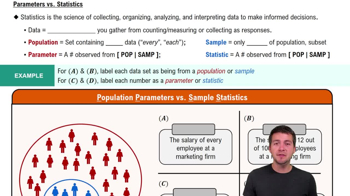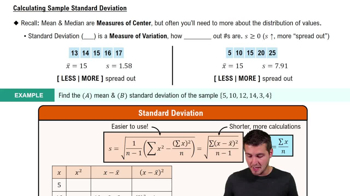Using Chebychev’s Theorem Old Faithful is a famous geyser at Yellowstone National Park. From a sample with n = 100, the mean interval between Old Faithful’s eruptions is 101.56 minutes and the standard deviation is 42.69 minutes. Using Chebychev’s Theorem, determine at least how many of the intervals lasted between 16.18 minutes and 186.94 minutes. (Adapted from Geyser Times)
Table of contents
- 1. Intro to Stats and Collecting Data1h 14m
- 2. Describing Data with Tables and Graphs1h 55m
- 3. Describing Data Numerically2h 5m
- 4. Probability2h 16m
- 5. Binomial Distribution & Discrete Random Variables3h 6m
- 6. Normal Distribution and Continuous Random Variables2h 11m
- 7. Sampling Distributions & Confidence Intervals: Mean3h 23m
- Sampling Distribution of the Sample Mean and Central Limit Theorem19m
- Distribution of Sample Mean - Excel23m
- Introduction to Confidence Intervals15m
- Confidence Intervals for Population Mean1h 18m
- Determining the Minimum Sample Size Required12m
- Finding Probabilities and T Critical Values - Excel28m
- Confidence Intervals for Population Means - Excel25m
- 8. Sampling Distributions & Confidence Intervals: Proportion1h 25m
- 9. Hypothesis Testing for One Sample3h 29m
- 10. Hypothesis Testing for Two Samples4h 50m
- Two Proportions1h 13m
- Two Proportions Hypothesis Test - Excel28m
- Two Means - Unknown, Unequal Variance1h 3m
- Two Means - Unknown Variances Hypothesis Test - Excel12m
- Two Means - Unknown, Equal Variance15m
- Two Means - Unknown, Equal Variances Hypothesis Test - Excel9m
- Two Means - Known Variance12m
- Two Means - Sigma Known Hypothesis Test - Excel21m
- Two Means - Matched Pairs (Dependent Samples)42m
- Matched Pairs Hypothesis Test - Excel12m
- 11. Correlation1h 6m
- 12. Regression1h 50m
- 13. Chi-Square Tests & Goodness of Fit1h 57m
- 14. ANOVA1h 57m
3. Describing Data Numerically
Standard Deviation
Problem 2.R.28
Textbook Question
In Exercises 27 and 28, find the range, mean, variance, and standard deviation of the sample data set.
Salaries (in dollars) of a random sample of teachers
62,222 56,719 50,259 45,120 47,692 45,985 53,489 71,534
 Verified step by step guidance
Verified step by step guidance1
Step 1: Calculate the range of the data set. The range is the difference between the maximum and minimum values in the data set. Identify the maximum value (71,534) and the minimum value (45,120), then compute the range as Range = Max - Min.
Step 2: Calculate the mean (average) of the data set. Add all the salary values together and divide by the total number of data points. Use the formula: Mean = (Σx) / n, where Σx is the sum of all data points and n is the number of data points.
Step 3: Compute the variance of the sample. First, subtract the mean from each data point to find the deviation of each value. Then square each deviation, sum them up, and divide by (n - 1), where n is the number of data points. Use the formula: Variance = (Σ(x - Mean)²) / (n - 1).
Step 4: Calculate the standard deviation of the sample. The standard deviation is the square root of the variance. Use the formula: Standard Deviation = √Variance.
Step 5: Summarize the results. Report the range, mean, variance, and standard deviation of the sample data set, ensuring all calculations are accurate and clearly presented.
 Verified video answer for a similar problem:
Verified video answer for a similar problem:This video solution was recommended by our tutors as helpful for the problem above
Video duration:
3mPlay a video:
Was this helpful?
Key Concepts
Here are the essential concepts you must grasp in order to answer the question correctly.
Descriptive Statistics
Descriptive statistics summarize and describe the main features of a data set. This includes measures such as the mean (average), variance (measure of data spread), and standard deviation (average distance from the mean). These statistics provide a quick overview of the data's central tendency and variability, which are essential for understanding the overall distribution of the sample.
Recommended video:
Guided course

Parameters vs. Statistics
Range
The range is a simple measure of variability that indicates the difference between the highest and lowest values in a data set. It provides a quick sense of the spread of the data but does not account for how the values are distributed within that range. In the context of the given salaries, calculating the range helps to understand the extent of salary variation among the sampled teachers.
Recommended video:
Guided course

Find 5-Number Summary - TI-84 Calculator Example 1
Variance and Standard Deviation
Variance measures how far each number in the data set is from the mean and thus from every other number. It is calculated as the average of the squared differences from the mean. Standard deviation, the square root of variance, provides a more interpretable measure of spread in the same units as the data. Both are crucial for assessing the consistency and reliability of the data set.
Recommended video:
Guided course

Calculating Standard Deviation

 8:45m
8:45mWatch next
Master Calculating Standard Deviation with a bite sized video explanation from Patrick
Start learningRelated Videos
Related Practice
Textbook Question
